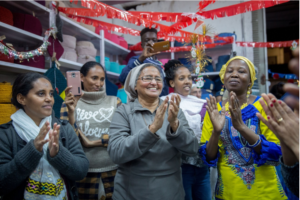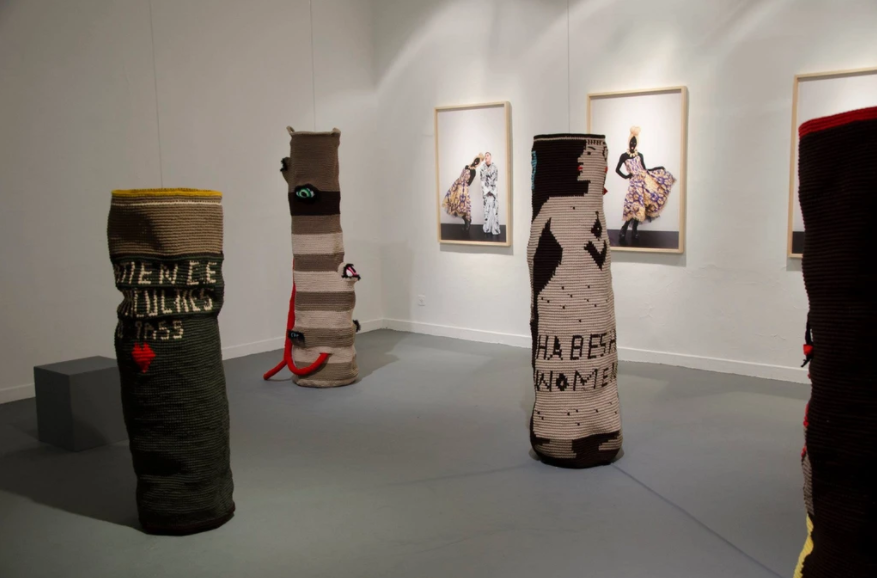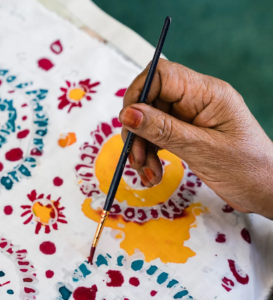
Art therapy is not just used in Western countries but utilised across the globe. In particular it is a useful tool when language is an issue. The benefits of art therapy are even more vital for vulnerable groups such as the elderly, the young, or refugees. For example many refugees who have escaped persecution from African countries will have harrowing experiences to process. This is why organisations like Kuchinate are helping ease the pain of integration by providing a supportive community for those who are exiled. Many of the women are survivors of rape, abuse, torture or trafficking.
Christabel Johanson on art as therapy for African refugees
Photo: Miri Davidovitz
Art as Therapy
When the topic of art is mentioned in general conversation it is sometimes perceived as an indulgent pastime or a pursuit reserved for rich collectors. Often people don’t see its value beyond the aesthetics. However art and its related creative outlets are more than just an indulgence. Its benefits are many. For some it can aid with mindfulness, for others it can be the bridge back into good mental health; art can be a way to express trauma or pain and the process of making the art can itself be the therapy.
One advantage of art is its accessibility. Someone may simply grab a pen and paper, begin to draw and get lost in the process. Another advantage is how varied art forms can be. Painting, sculpting, colouring are all valid expressions which release the emotions bubbling under the surface. For those people working through trauma, depression, anxiety and other types of mental disturbances, art allows the creator to pour out their psychological narrative. This “brain dump” can manifest as symbolic expression, icons, colour-codes and so forth. When coupled with a trained professional to facilitate the activities, the creators can understand their work better in order to resolve deep-rooted problems.
No prior experience or talent is necessary to participate. The goal is to tell personal stories, reconnect the artist to their emotions or explore memories. To work without judgement alongside others of a similar experience opens up conversation with each other. Questions are asked, dialogue is exchanged and memories are shared because practising art in this way is disarming. Although there may be difficult feelings to work through, the users are able to get there together.

Design Hafza Yussup studio, London
Art therapy is not just used in Western countries but utilised across the globe. In particular it is a useful tool when language is an issue. The benefits of art therapy are even more vital for vulnerable groups such as the elderly, the young, or refugees. For example many refugees who have escaped persecution from African countries will have harrowing experiences to process. This is why organisations like Kuchinate are helping ease the pain of integration by providing a supportive community for those who are exiled. Many of the women are survivors of rape, abuse, torture or trafficking.
*
When these refugees seek asylum in other countries there are usually problems. For instance cities like Tel Aviv have seen a rise in African asylum seekers within the last 10 years. As with most refugees they are marginalised from society both culturally and financially, leaving their options limited. Pile onto this the stress of dealing with mental wounds, then it is easy to see how relocating to a new country continues the stress and suffering they have so far endured.
*
One refugee describes her experience of moving, “In Israel, it is very difficult; I have no work and I have to pay for food and rent. My dream is that my child will feel good. If God gives health to my child, that is enough for me. I love Kuchinate because at home I worry all the time and think about what will happen to us, what will happen to our child, and how we are going to have enough food and money. Here at Kuchinate, I see other mothers with children; I look at them and see that they all have problems too. Everyone who comes to Kuchinate suffers, so here I am not alone.”

Sister Azezet Kidane, co-Director of the Kuchinate collective, dances together with women at their annual Christmas party in the Kuchinate workshop in south Tel Aviv on January 9, 2018. (Miriam Alster/Flash90)
Kuchinate has provided a lifeline for its 150 or so women from Eritrea, Nigeria, Sudan and other African countries. The group’s name translates as “crotchet” which is their primary activity. By providing a studio space, these women have a safe place to work and bond together, share their stories and support themselves mentally and emotionally. In 2018 the group collaborated with Israeli artist Gil Yefman to create a diverse range of art work. The theme was around childhood memories, contrasted against their current situation in Israel. These pieces have toured to the USA and exhibited at the “Remember the Women Institute” at the Ronald Fedman Fine Arts Gallery.
 Kuchinate exhibition, Haifa Museum of Art
Kuchinate exhibition, Haifa Museum of Art
Kuchinate is member to a larger body called the A.R.T.S. organisation (which stands for “African Refugee Therapeutic Services”). The service is a non-profit organisation which seeks to empower asylum seekers by backing projects that rehabilitate female refugees through a range of activities. By making art derived from an African heritage the users are able to connect with their culture even though they are displaced from it. These ventures can also help refugees in practical ways such as provide a small income from the sales of work.
*
Artists for Refugees which is funded by the UNHCR (United Nations High Commission for Refugees) is another art initiative that has supported communities living in camps within Kenya. Started in 2015 the group provide vital artistic steer and not only help the refugees with therapeutic release but also challenge negative assumptions about them. One spokesperson said, “The project aims to give the refugees a voice and an opportunity to express themselves using art as a source of livelihood and also as a form of therapy. The project also seeks to keep refugees occupied so as to avoid potential risk of getting involved in criminality.” The initiative is led by Henry Ohanga (musician and rapper) and Victor Ndula (artist and illustrator). The duo mentor the refugees not only in the creative process but in harnessing this expression to show wider society that they are good, law-abiding citizens with a lot of value to offer their new home. Together this challenges the mainstream perceptions and fears towards refugees.

Kakuma and Daadab refugee camps in Kenya. Nairobi exhibition, 2015
In 2015 the group held four training workshops in Kakuma refugee camp which culminated in a showcase at the “World Refugee Day” including an exhibition of the visual artists’ work. Later that year a small group of refugees joined Henry Ohanga (stage name Octopizzo) on stage in Nairobi. Finally in November of that same year the group were able to display their art and musical efforts in Nairobi which was applauded by the public and various humanitarian organisations.
Over in Britain, Hafza Studio nestled in East London specialises in design and exclusive fabric prints. Founded by Hafza Yusuf a British Somali textile designer, Hafza Studio combines traditional hand painting with digital printing. The studio provides workshops for the Somalian community including elderly and young members.

Hafza Studio, traditional hand painted textiles
“We believe that art therapy gives people of all ages and backgrounds an opportunity to express their individuality, and everyone has the right to experience this.” Creating these textiles help Somalians explore their heritage as well as promote Somali culture within Britain. Although London is a multi-cultural city, there are pockets of communities all over the boroughs and sometimes it is hard to integrate between these groups. This is where grassroots initiatives like Hafza Studios play a part in connecting people. Through the beauty of their art work and designs, collectors and the public alike can find a new appreciation for Somali culture. This breeds compassion and empathy for a community who have otherwise been very insular and separate within the capital.
*
So whether art is working on a global or grassroots scale, it is clear that the power of creative healing is very much a real and necessary element of rehabilitation. For those whose trauma cannot find words, art gives them the pictures, colours and space to find a voice and express the emotions within. The value of art therapy is only really gaining the credibility and momentum it deserves – because for these people art is not only needed to survive but to thrive.
